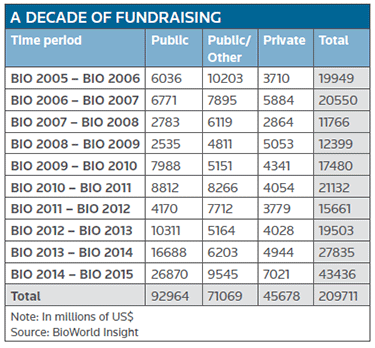
My, my, how you've grown! Look at what a difference a decade makes
Print
22 June 2015
Peter Winter / BioWorld
PHILADELPHIA – The Biotechnology Industry Organization's (BIO) International Convention returns to the City of Brotherly Love this week after a decade since BIO 2005 convened here. In the period that has elapsed between events, the industry is hardly recognizable to what it was way back in 2005. The speed of biotech's growth has been truly remarkable, especially given the low point reached during the financial markets meltdown.
For long-time biotech industry stalwarts who made the trek to Philadelphia for the BIO 2005 International Convention they might recall that the event was accompanied by dramatic daily protests involving red, blue and green color-coordinated protest marches, specifically aimed at providing an opposing viewpoint to BIO. (See BioWorld Today, June 22, 2005.)
Organized by Biodemocracy 2005 – basically the same group behind protests at BIO 2004 in San Francisco but operating under a different name – they held a counter-conference that ran for five days in the city.
With protests during meetings diminishing in size each year, this is one obvious indication of how the industry has matured since then, reflecting the fact that people are recognizing that biotechnology has begun to deliver on its promise of improving health through innovative therapies and technologies. In fact, we have begun to see much more positive involvement in biotech by patient advocacy organizations. For smaller biotech companies, that has become an increasingly attractive avenue to speed development of drugs, particularly for rare indications, by partnering with thoses groups to help move product candidates into clinical development.
BY THE NUMBERS
The dramatic growth of the biotech sector is evidenced by the 459 percent increase in value of the Nasdaq Biotechnology Index since BIO 2005. In the same period, the Dow Jones Industrial average grew 75 percent. (See Share Price/Index Value at Close of BIO Meetings, 2005-2015, below.)

By the close of BIO 2005, Genentech Inc., which was destined to become a unit of Roche AG, had a market capitalization of about $86 billion; Amgen Inc. was holding down the No. 2 spot with a market cap of nearly $77 billion. Gilead Sciences Inc., the third-ranked biotech firm by market cap, was a distant third at just less than $20 billion. (See BioWorld Insight, June 27, 2005.)
Amgen has remained an industry stalwart and has steadily grown to command a market cap of around $118 billion. The growth story of the decade, however, belongs to Gilead, which now occupies the top spot in terms of market cap at $172 billion.
The growing valuation of the sector is a common theme of the decade – from a handful of companies with market caps above $1 billion in 2005 – and the landscape of the industry has changed dramatically with more 90 public companies members of the $1 billion club today. In fact, the industry now has a market cap valuation of just over $1 trillion.
UMBILICAL CORD
The common factor between then and now is financing. For biotech companies it is their umbilical cord, without it the industry cannot thrive. For a time, with the financial markets in turmoil, some observers believed that the number of companies would be dramatically reduced. While attrition was part of that tough financial environment, those that did survive have gone on to thrive.
As The Decade of Financing chart shows there was a dramatic drop off in biotech financing in 2008 and 2009. The recovery has been truly remarkable and it looks like we are on pace for another incredible year. (See A Decade of Fundraising, below.)

FACTS ABOUT BIO 2005
BIO 2005 ended its four-day run at the Philadelphia Convention Center with new records for attendance and international representation. Total registration was 18,730, with representatives from 56 countries and all 50 U.S. states.
More than 500 journalists from 36 countries covered BIO 2005.
Jim Greenwood was about five months into his position of president and CEO of BIO.
The exhibit hall featured a 1,525 displays, with more than 60 state and international pavilions.
More than 200 companies delivered business presentations.
More than 900 speakers shared their expertise in 180 program sessions.
BIO 2005's economic impact on the city of Philadelphia – its hotels, restaurants, taxi operators, etc. – was estimated at more than $35 million (NB: This time around the figure is estimated by BIO to hit $45 million).
All Portfolio
MEDIA CENTER
-
The RMI group has completed sertain projects
The RMI Group has exited from the capital of portfolio companies:
Marinus Pharmaceuticals, Inc.,
Syndax Pharmaceuticals, Inc.,
Atea Pharmaceuticals, Inc.

